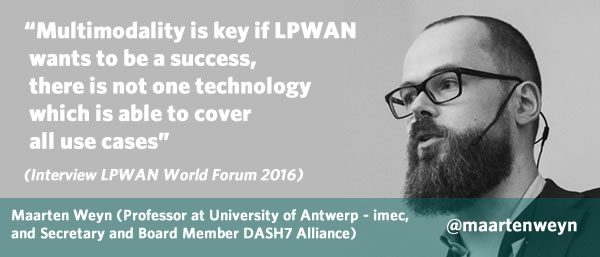In November, London was the place to be to discuss about the future of Internet of Things networks, more specifically low power, wide area or LPWA networks.
On top of non-cellular low-power wide-area network players such as Sigfox, The LoRa Alliance and Weightless, the cellular LPWAN market was also represented, with among others the GSMA, Vodafone and the 3GPP, to name a few.
The evolutions in cellular LPWAN (with NB-IoT or Narrowband-IoT and the second of 3 new 3GPP standards, LTE-M, being the main ones) were of course tackled with the finalization of the standardization of NB-IoT, LTE-M (or eMTC to be precise) and EC-GSM-IoT was announced earlier 2016 by 3GPP in its release 13.
As the 3GPP put it in a press release ‘with the completion of the NB-IOT, 3GPP has concluded a major effort in Release 13 to address the IoT market’. Yet, the effects won’t be seen right away as you know (delay and a long way ahead before deployments), so food for discussion at the LPWAN World Forum for sure.

LPWAN in flux
Apart from the various LPWA connectivity ecosystems, the event had a great list of speakers.
The nice thing about the speaker list and agenda is that you got a mix of analysts , academics, various ecosystem players and associations who discussed more about the importance of the use case and the business side of things in a developing market where there is still room for several IoT connectivity tech approaches.
Commenting on the importance of LPWAN at the occasion of the LPWAN World Forum, ABI Research Senior Analyst Adarsh Krishnan, who also was a speaker at the event, stated that LPWA network technologies are really beginning to take momentum. Krishnan: “As this industry grows and develops, the market is transitioning from private to public networks, with 66% if total end-points predicted to be connected by public networks by 2021. Already, utilities and smart city service providers are increasingly willing to test and trial public LPWA networks”.
The event organizers emphasized that LPWAN technology is absolutely critical to the delivery and realization of IoT. There were quite some cases announced too; from various integrators but also from companies such as Schiphol Group where some interesting IoT projects have been deployed with LoRaWAN in The Netherlands to community initiatives such as the flood network in the UK which we covered previously.
Maarten Weyn on the future of LPWAN
One of the many other speakers was Professor Maarten Weyn from the University of Antwerp and secretary and board member of the DASH7 Alliance.
When he was asked if there is a place for multiple LPWAN technologies to co-exist long-term or if eventually one technology will dominate in an interview at the occasion of the event, Maarten Weyn answered: “Multimodality is key if LPWAN wants to be a success, there is not one technology which is able to cover all use cases”.
We couldn’t agree more. It’s the IoT use case and what it needs that should come first and not all IoT use cases are best served by one LPWAN technology given many factors that can play an important role. The experts seemed to agree that a mix of licensed and unlicensed is best and, indeed, that the use case – or business case – is what makes the differentiating factor.
Talking about IoT use cases, Maarten Weyn summarized the best use cases for LPWAN – as he sees them – as follows: ‘sporadic monitoring or control of sensor and actuators where energy consumption, mobility, multimodality (technology and environment) are key issues, without the need for fast response time’.
Asked about NB-IoT and how ‘disruptive’ the commercial deployment of NB-IoT would be, Weyn replied that he thinks that NB-IoT will move applications which are not mend to be used in a license free frequency band – without a possibility of guaranteed connectivity – to a licensed band – where you can give guarantees.
Yet, we aren’t there. Will the delay in NB-IoT deployment jeopardise its traction long-term?
Maarten Weyn: “Of course licence free technologies will try to grasp as much as possible of that market. But the choice of a technology is for a lot of companies more a choice of the business model (where is the data, API, … ) of the provider then a real technology choice.”
For organizations and individuals who want to decide which LPWAN technology to use for a specific use case the main thing, per Weyn, is to make sure that they are not locked in since a lot will happen in the coming years. That’s for sure.
Asked about what the future holds for LPWAN, Maarten Weyn believes that it will take at least two more years before we go from a marketing use of LPWAN to real use of LPWAN where every application is matched with the best-fitted technology.
Maarten Weyn’s research in the imec-IDlab research group at the University of Antwerp focuses on ultra-low power sensor communication and embedded systems, sub 1-Ghz communication, sensor processing and localization.
LPWAN World Forum is a 2 day conference and exhibition covering Low Power Wide Area Networks and its impact on IoT technology (update 2019: this event is not organized anymore).

